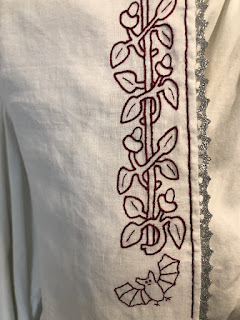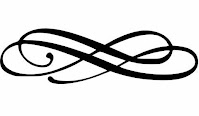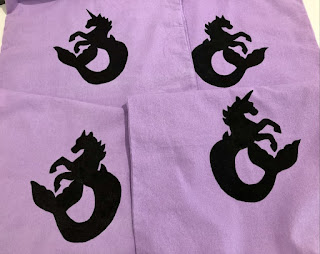Here is a project that I finished last month- bags with a painted heraldic device.
I strive to cover up mundanities at events, but sometimes, when I'm in a rush, I have forgotten to bring cloths to cover up with. To help remedy this problem, I decided to paint some bags with a version of my heraldic device.
The 'stencil' was one of a set of birthday decorations that my sister bought me last year. I just love it. The bags are commercially produced cotton bags available from Spotlight stores.
I traced around the seahorse stencil carefully with pencil. I used pencil rather than frixion marker just in case the paint made the marker ink run. I suggest pre-washing your fabric also.
I used black acrylic paint mixed with a textile medium to create fabric paint. The design needed two layers (and touch ups) to get a nice even coverage.
I cut open plastic shopping bags and slid them inside the fabric bags to stop the paint from running through to the other side. I would not recommend paper for this, as is will stick to the inside of the fabric and can be almost impossible to remove. (Ask me how I know 😏 )
When the first side was complete and dry, I put the bag up against a glass door and traced the design in reverse on the other side. I then followed the same process as above.
Follow the manufacturer's instructions on the textile medium, and wash out your brush often as the paint builds up and hardens quite quickly.
The textile medium that I was using is heat set, so when the paint was dry and the plastic bag insert was removed, I laid a large paper bag on the ironing board. I put my painted bag on top and then put another paper bag on top of the painted area. I just used a cut open (clean) lunch bag. The paper stops any paint residue from being spread around and protects the painted area from burning. I also turned the steam option on my iron off, but make sure to follow the instructions on the textile medium, because there are several different brands around.
This project took longer than I expected, but was fun. I plan to do more painted fabric projects in the future. Painting fabric provides a good visual impact without the time commitment of applique or embroidery.
Painting on fabric is a period technique; Cennino d'Andrea Cennini discusses it in section X of 'Il Libro dell'Arte'. Modern acrylics and textile medium are much easier and faster to use than gesso and lead paints, and certainly safer. Time will tell how well the textile medium wears and stands up to washing.
Dover Publications 'The Craftsman's Handbook (Il Libro dell'Arte) translated by Daniel V Thompson Jr (1960) [https://store.doverpublications.com/048620054x.html] is an inexpensive reproduction which will be of interest to SCA painters and craftspeople. It gives an insight into artistic practices common in Italy in the Renaissance.























